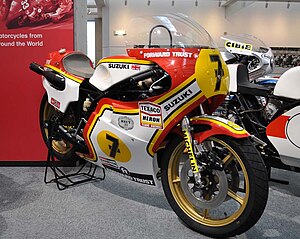
Grand Prix motorcycle racing is the premier class of motorcycle road racing events held on road circuits sanctioned by the Fédération Internationale de Motocyclisme (FIM). Independent motorcycle racing events have been held since the start of the twentieth century and large national events were often given the title Grand Prix. The foundation of the Fédération Internationale de Motocyclisme as the international governing body for motorcycle sport in 1949 provided the opportunity to coordinate rules and regulations in order that selected events could count towards official World Championships. It is the oldest established motorsport world championship.


Giacomo Agostini is an Italian former Grand Prix motorcycle road racer. Nicknamed Ago, he amassed 122 Grand Prix wins and 15 World Championship titles. Of these, 68 wins and 8 titles came in the 500 cc class, the rest in the 350 cc class. For these achievements obtained over the course of a career spanning 17 years, the AMA described him as "...perhaps the greatest Grand Prix rider of all time". In 2000, Agostini was inducted into the MotoGP Hall of Fame as a MotoGP Legend, while in 2010, he was named an FIM Legend for his motorcycling achievements.

Randy Mamola is an American former professional motorcycle racer and television sports presenter. He competed in Grand Prix motorcycle racing between 1979 and 1992. A 13-time Premier Class race winner, Mamola was one of the most charismatic Grand Prix road racers of his generation, becoming a favourite because of his interaction with race fans both on and off the track as well as his aggressive and spirited riding style.

Pat Hennen is an American former Grand Prix motorcycle road racer. He is notable for being the first American to win a 500 cc World Championship race, the 1976 500cc Finnish Grand Prix. Competing as a non-factory rider, he finished third overall in the GP World Championship standings that season, only 2 points behind runner-up Tepi Länsivuori and fellow Suzuki factory rider Barry Sheene.

The 1976 Grand Prix motorcycle racing season was the 28th F.I.M. Road Racing World Championship season.

The 1970 Grand Prix motorcycle racing season was the 22nd F.I.M. Road Racing World Championship Grand Prix season. The season consisted of twelve Grand Prix races in six classes: 500cc, 350cc, 250cc, 125cc, 50cc and Sidecars 500cc. It began on 3 May, with West German Grand Prix and ended with Spanish Grand Prix on 27 September.

NR500 was a racing motorcycle developed by Honda HRC in 1979 to compete in Grand Prix motorcycle racing. "NR" stands for "New Racing".

The Yamaha YZR500 was a for 500 cc Grand Prix racing motorcycle made by Yamaha from 1973 through 2002.
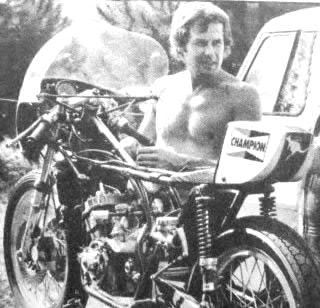
Cyril John Findlay was an Australian professional Grand Prix motorcycle road racer. He is noted for having one of the longest racing careers in Grand Prix history spanning 20 years, as well as one of four riders to race in Grand Prix motorcycle racing for 20 years or more. He competed at the highest level despite racing as a privateer - that is, not as a contracted member of a factory team - throughout most of his racing career.

Suzuki MotoGP was the factory-backed team of Japanese motorcycle manufacturer Suzuki in the MotoGP World Championship, most recently using the name Team Suzuki Ecstar for sponsorship purposes. Suzuki withdrew from MotoGP competition at the conclusion of the 2022 season, winning their final race with Álex Rins.

The MV Agusta 500cc Three (1965–1973) or MV Agusta Tre was a road racing motorcycle produced by the Italian manufacturer MV Agusta to compete in the 500 cc Grand Prix motorcycle racing World Championship. The motorcycle was introduced in 1966 to compete against the ever competitive Honda racing machines and was a bored out version of MV Agusta's highly successful 350 cc three cylinder. Giacomo Agostini won consecutive world championships in the 500 cc class with this motorbike from 1966 to 1972. In addition, MV Agusta won the Constructors' World Championships from 1967 to 1972. The MV Agusta Tre is considered the most successful racing motorcycle in history.

The Kawasaki KR500 was a racing motorcycle manufactured by Kawasaki from 1980 to 1982 for competition in the Grand Prix motorcycle racing series. The motorcycle was powered by a 494 cc two stroke engine, and used an aluminium monocoque frame, similar to the 1979 Honda NR500 racer, aimed at improving aerodynamics with a small frontal area, improving chassis stiffness and reducing weight.

The Honda RC143 was the Honda racing team's 125cc Grand Prix motorcycle racer for the 1960 season. That was the first time the Honda team would compete in an entire season's racing. The bike was a major step forward from the previous year's machines, and though still outpaced by its more experienced European rivals, it revealed to seasoned competitors like Luigi Taveri that Honda would quickly become a force to be reckoned with.
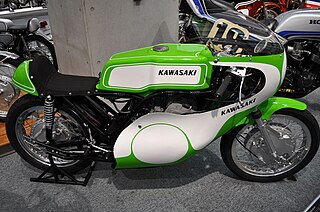
The Kawasaki H1R was racing motorcycle manufactured by Kawasaki which competed in the 500 cc class of Grand Prix motorcycle racing. Based on the Kawasaki H1 street motorcycle, it was powered by a two stroke, three cylinder engine set across the frame. It was the first multi-cylinder two stroke racing motorcycle to be sold commercially to privateer racing teams.

Danny Ray Kent is an English motorcycle racer, best known for winning the 2015 Moto3 World Championship. In doing so he became Great Britain's first Grand Prix solo motorcycle world champion since Barry Sheene in 1977, as well as the first British lightweight class champion since Dave Simmonds in 1969.
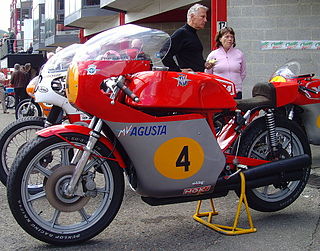
The MV Agusta 500cc road racers were motorcycles that the manufacturer MV Agusta built and which were used to compete in 500cc Grand Prix motorcycle racing series between 1950 and 1976. 18 500cc world championship titles were achieved with these machines ridden by John Surtees, Gary Hocking, Mike Hailwood, Giacomo Agostini and Phil Read between 1958 and 1974.

The MV Agusta 500 four-cylinder (1973–1976) was a racing motorcycle manufactured by the Italian company MV Agusta, for competing in the 500 cc series, the premier class of the FIM World Motorcycle Championship. With this motorcycle MV Agusta won the 1973 constructor's world champion and Phil Read won the 1973 and 1974 500 cc riders world championships.
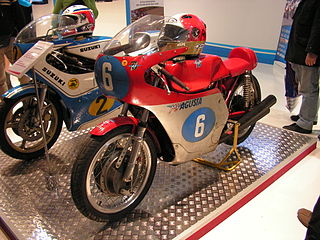
The MV Agusta 350 cc racers were motorcycles produced by MV Agusta between 1954 and 1976 and raced in the 350 cc motorcycle GP championships. 10 world titles were achieved by riders John Surtees, Gary Hocking and Giacomo Agostini on these machines.
The MV Agusta 250 Bicilindrica was a 250 cc factory racing motorcycle manufactured by the Italian brand MV Agusta from 1957 to 1961. With this machine 11 GPs, 2 Driver Championships and 2 manufacturers World Championships were won.
